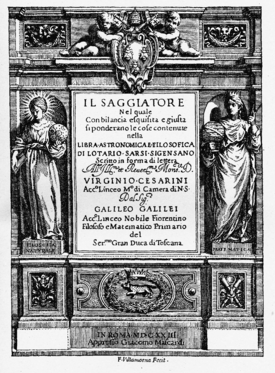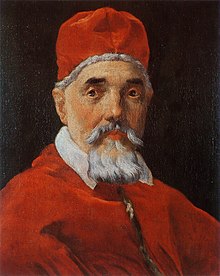The Assayer

The Assayer (Italian: Il Saggiatore) is a book by Galileo Galilei, published in Rome in October 1623. It is generally considered to be one of the pioneering works of the scientific method, first broaching the idea that the book of nature is to be read with mathematical tools rather than those of scholastic philosophy, as generally held at the time.
Background – Galileo vs. Grassi on comets[edit]
In 1619, Galileo became embroiled in a controversy with Father Orazio Grassi, professor of mathematics at the Jesuit Collegio Romano. It began as a dispute over the nature of comets, but by the time Galileo had published The Assayer, his last salvo in the dispute, it had become a much wider controversy over the very nature of science itself.
An Astronomical Disputation[edit]
The debate between Galileo and Grassi started in early 1619, when Father Grassi anonymously published the pamphlet, An Astronomical Disputation on the Three Comets of the Year 1618 (Disputatio astronomica de tribus cometis anni MDCXVIII),[1] which discussed the nature of a comet that had appeared late in November of the previous year. Grassi concluded that the comet was a fiery, celestial body that had moved along a segment of a great circle at a constant distance from the earth,[2][3] and since it moved in the sky more slowly than the Moon, it must be farther away than the Moon.
Tychonic system[edit]
Grassi adopted Tycho Brahe's Tychonic system, in which the other planets of the Solar System orbit around the Sun, which, in turn, orbits around the Earth. In his Disputatio Grassi referenced many of Galileo's observations, such as the surface of the Moon and the phases of Venus, without mentioning him. Grassi argued from the apparent absence of observable parallax that comets move beyond the Moon. Galileo never explicitly stated that comets are an illusion, but merely wondered if they are real or an optical illusion.
Discourse on Comets[edit]
Grassi's arguments and conclusions were criticised in a subsequent pamphlet, Discourse on Comets,[4] published under the name of one of Galileo's disciples, a Florentine lawyer named Mario Guiducci, although it had been largely written by Galileo himself.[5] Galileo and Guiducci offered no definitive theory of their own on the nature of comets,[6][7] although they did present some tentative conjectures that are now known to be mistaken. (The correct approach to the study of comets had been proposed at the time by Tycho Brahe.) In its opening passage, Galileo and Guiducci's Discourse gratuitously insulted the Jesuit Christoph Scheiner,[8][9][10] and various uncomplimentary remarks about the professors of the Collegio Romano were scattered throughout the work.[8]
The Astronomical and Philosophical Balance[edit]
The Jesuits were offended,[7][8] and Grassi soon replied with a polemical tract of his own, The Astronomical and Philosophical Balance (Libra astronomica ac philosophica),[11] under the pseudonym Lothario Sarsio Sigensano, purporting to be one of his own pupils.
The Assayer[edit]
The Assayer was Galileo's devastating reply to the Astronomical Balance.[12] It has been widely recognized as a masterpiece of polemical literature,[13][14] in which "Sarsi's" arguments are subjected to withering scorn.[15] It was greeted with wide acclaim, and particularly pleased the new pope, Urban VIII, to whom it had been dedicated.[16] In Rome, in the previous decade, Barberini, the future Urban VIII, had come down on the side of Galileo and the Lincean Academy.[17]
Galileo's dispute with Grassi permanently alienated many Jesuits,[18] and Galileo and his friends were convinced that they were responsible for bringing about his later condemnation,[19] although supporting evidence for this is not conclusive.[20][21]
Science, mathematics, and philosophy[edit]

In 1616 Galileo may have been silenced on Copernicanism. In 1623 his supporter and friend, Cardinal Maffeo Barberini, a former patron of the Accademia dei Lincei and uncle of future Cardinal Francesco Barberini, became Pope Urban VIII. The election of Barberini seemed to assure Galileo of support at the highest level in the Church. A visit to Rome confirmed this. The Assayer is a milestone in the history of science: here Galileo describes the scientific method, which was quite a revolution at the time.
The title page of The Assayer shows the crest of the Barberini family, featuring three busy bees. In The Assayer, Galileo weighs the astronomical views of a Jesuit, Orazio Grassi, and finds them wanting. The book was dedicated to the new pope. The title page also shows that Urban VIII employed a member of the Lynx, Cesarini, at a high level in the papal service. This book was edited and published by members of the Lynx.
In The Assayer Galileo mainly criticized Grassi's method of inquiry, heavily biased by his religious belief and based on ipse dixit, rather than his hypothesis on comets. Furthermore, he insisted that natural philosophy (i.e. physics) should be mathematical. According to the title page, he was the philosopher (i.e. physicist) of the Grand Duke of Tuscany, not merely the mathematician. Natural philosophy (physics) spans the gamut from processes of generation and growth (represented by a plant) to the physical structure of the universe, represented by the cosmic cross-section. Mathematics, on the other hand, is symbolized by telescopes, and an astrolabe.
The language of science[edit]
The Assayer contains Galileo's famous statement that mathematics is the language of science. Only through mathematics can one achieve lasting truth in physics. Those who neglect mathematics wander endlessly in a dark labyrinth. From the book:[22]
Philosophy [i.e. natural philosophy] is written in this grand book — I mean the Universe — which stands continually open to our gaze, but it cannot be understood unless one first learns to comprehend the language and interpret the characters in which it is written. It is written in the language of mathematics, and its characters are triangles, circles, and other geometrical figures, without which it is humanly impossible to understand a single word of it; without these, one is wandering around in a dark labyrinth.
Galileo used a sarcastic and witty tone throughout the essay. The book was read with delight at the dinner table by Urban VIII.[17] In 1620 Maffeo Barberini wrote a poem entitled Adulatio Perniciosa in Galileo's honor.[23] An official, Giovanni di Guevara, said that The Assayer was free from any unorthodoxy.[24]
Smell, taste, and particles of matter[edit]
Also in the book, Galileo theorized that senses such as smell and taste are made possible by the release of tiny particles from their host substances, which was correct but not proven until later.[25]
And those minute particles which rise up may enter by our nostrils and strike upon some small protuberances which are the instrument of smelling; here likewise their touch ... is received to our like or dislike according as they have this or that shape, are fast or slow, and are numerous or few.[26]
See also[edit]
References[edit]
Citations[edit]
- ^ Grassi 1960a, p. 3-19.
- ^ Drake 1978, p. 268.
- ^ Grassi 1960a, p. 16.
- ^ Guiducci 1960, p. 21–65.
- ^ Drake 1960, p. xvi.
- ^ Drake 1957, p. 222.
- ^ a b Drake 1960, p. xvii.
- ^ a b c Sharratt 1994, p. 135.
- ^ Drake 1960, p. xii.
- ^ Guiducci 1960, p. 24.
- ^ Grassi 1960b, p. 67–132.
- ^ Guiducci 1960.
- ^ Sharratt 1994, p. 137.
- ^ Drake 1957, p. 227.
- ^ Sharratt 1994, pp. 138–142.
- ^ Drake 1960, p. xix.
- ^ a b Alexander 2014, p. 131.
- ^ Drake 1960, p. vii.
- ^ Sharratt 1994, p. 175.
- ^ Sharratt 1994, pp. 175–178.
- ^ Blackwell 2006, p. 30.
- ^ Galilei 1957, p. 237-8.
- ^ The Galileo Project
- ^ William A. Wallace, Galileo, the Jesuits and the Medieval Aristotle, (1991), pp.VII, 81-83
- ^ Fermi 1961, p. 6.
- ^ Galilei 1957, p. 276.
References[edit]
- Alexander, A. (2014). Infinitesimal: How a Dangerous Mathematical Theory Shaped the Modern World. Scientific American / Farrar, Straus and Giroux.
- Blackwell, R. J. (2006). Behind the Scenes at Galileo's Trial. University of Notre Dame Press.
- Drake, S. (1957). "Introduction: Fourth part". In Drake, S. (ed.). Discoveries and opinions of Galileo (PDF). Doubleday Anchor Books.
- Drake, S. (1960). "Introduction". In Drake, S.; O'Malley, C. D. (eds.). The controversy on the comets of 1618. University of Pennsylvania Press. JSTOR j.ctv4v327m.
- Drake, S. (1978). Galileo at work: His scientific biography. University of Chicago Press.
- Fermi, Laura (1961). The Story of Atomic Energy. New York: Random House. LCCN 61007589. OCLC 1406822.
- Galilei, G. (1957) [1623]. "The Assayer". In Drake, S. (ed.). Discoveries and Opinions of Galileo (PDF). Doubleday.
- Galilei, G. (1960) [1623]. "Il Saggiatore" [The Assayer]. In Stillman Drake; C. D. O'Malley (eds.). The Controversy on the Comets of 1618 (in Italian). University of Pennsylvania Press.
- Grassi, H. (1960a). "On the three comets of the year 1618". In Drake, S.; O'Malley, C. D. (eds.). The controversy on the comets of 1618. University of Pennsylvania Press. JSTOR j.ctv4v327m.
- Grassi, H. (1960b). "The astronomical and philosophical balance (pp. 67–132)". In Drake, S.; O'Malley, C. D. (eds.). The controversy on the comets of 1618. University of Pennsylvania Press. JSTOR j.ctv4v327m.
- Guiducci, M. (1960) [1619]. "Discourse on the comets". In Drake, S.; O'Malley, C. D. (eds.). The controversy on the comets of 1618. University of Pennsylvania Press. JSTOR j.ctv4v327m.
- Pietro Redondi, Galileo eretico, 1983; Galileo: Heretic (transl: Raymond Rosenthal) Princeton University Press 1987 (reprint 1989 ISBN 0-691-02426-X); Penguin 1988 (reprint 1990 ISBN 0-14-012541-8)
- Sharratt, M. (1994). Galileo: Decisive innovator. Cambridge University Press.
- Wallace, William A. (1991). Galileo, the Jesuits and the Medieval Aristotle.
